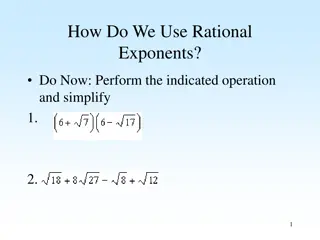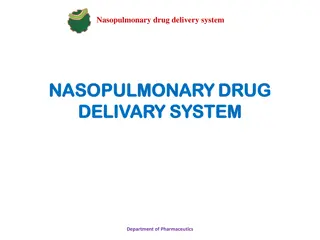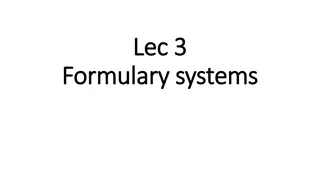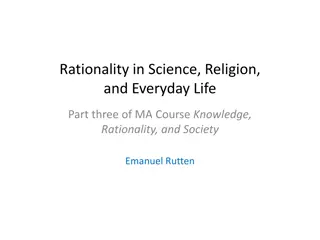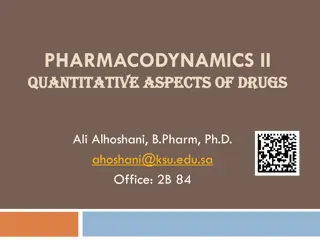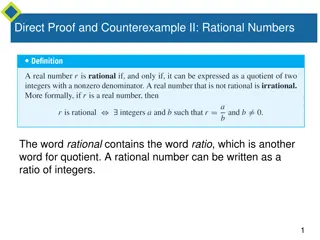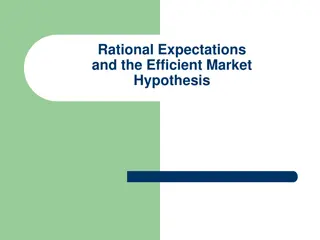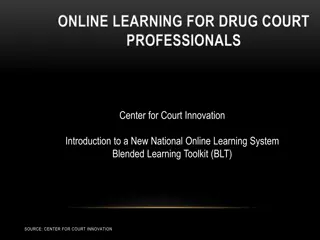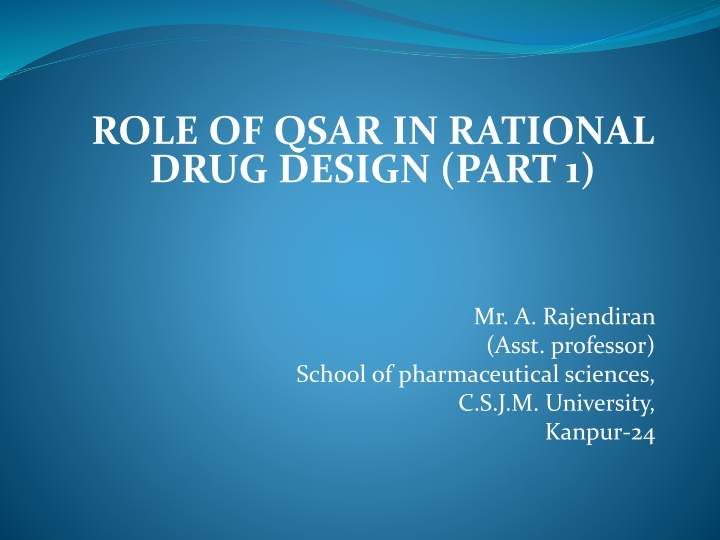
QSAR in Rational Drug Design: Understanding the Role and Evolution
Explore the role of Quantitative Structure-Activity Relationship (QSAR) in drug design, which aims to establish mathematical equations linking biological activity to physicochemical parameters. Learn about the history and development of QSAR, its importance in developing new drugs with high efficacy and low toxicity, and how it enhances the drug design process.
Download Presentation

Please find below an Image/Link to download the presentation.
The content on the website is provided AS IS for your information and personal use only. It may not be sold, licensed, or shared on other websites without obtaining consent from the author. If you encounter any issues during the download, it is possible that the publisher has removed the file from their server.
You are allowed to download the files provided on this website for personal or commercial use, subject to the condition that they are used lawfully. All files are the property of their respective owners.
The content on the website is provided AS IS for your information and personal use only. It may not be sold, licensed, or shared on other websites without obtaining consent from the author.
E N D
Presentation Transcript
ROLE OF QSAR IN RATIONAL DRUG DESIGN (PART 1) Mr. A. Rajendiran (Asst. professor) School of pharmaceutical sciences, C.S.J.M. University, Kanpur-24
Introduction- QSAR is an attempt to remove luck from drug design by establishing a Mathematical relationship in the form of an Equation between biological activity and measurable physicochemical Parameters. These parameters are used to represent properties such as lipophilicity, shape, electron distribution are major influence on drug activity. Lipophilicity is measure of a drugs solubility in lipid membranes. The electronic effects of groups with in the molecule will affects its electron distribution. Drug size and shape will determine whether the drug molecule is able target closure to enough to its target site in order to bind to that site. QSAR derived equation in general function[parameter(s)]. In which the activity is normally expressed as log [1/ (concentration)], usually c ,the minimum conc. Required to cause a defined biological response. QSAR studies are normally carried out on group of related compounds. However, structurally divers sets of compounds are becoming more common . form: Biological activity= 1
Drug design aim to develop new drug candidate with high chemotherapeutic index and low toxicity. To compare the effectiveness of different compounds, Paul Ehrlich expressed drug selectivity, and effectiveness, in term of its chemotherapeutic index(CTI). Chemotherapeutic index defined as the relative efficacy and safety of drug indicated by Min Curative Dose/Maximum tolerated dose. In short MCD/MTD. Greater the this index , better drug as greater safety to the patient. LD50 and ED50: CTI has been updated to take into account the variability of individuals, now defined as its reciprocal, the therapeutic index or ratio: therapeutic index (TI) =lethal dose required to kill 50% of the test animals(LD50)/dose producing an effective therapeutic response in 50% of the test sample (ED50). In theory, the larger a therapeutic index , the greater margin of safety. In the past development of new drug with specific activities process normally goes synthesis-biological activity test cycle until desired activity is obtained. Today, the structure of receptors and function of enzymes are better Understood. This concept add anew phase to the cycle as drug design- synthesis-biological activities. 3
HISTORY & DEVELOPMENT : The concept of QSAR dates back to the 19th century. Crum brown and Fraser published equation in 1868 which to be 1st QSAR formulation: the physiological activity ( )was expressed as the function of chemical structure C. =(F C) Few decades later Richet, Meyer and Overton independently found linear relationship between Lipophilicity expressed as solubility or oil-water partition coefficient, and biological effects, like toxicity, and narcotic activity. Ferguson observed a cut-off of biological activities beyond a certain range of lipophilicity and gave a thermodynamic interpretation for non linear SAR. Bruice kharasch and winzler formulate group contribution to biological activity values in a series of thyroid hormone analogs. Which considered as a Free Wilson type analysis. In early sixties two quantitative approaches were developed, one by Hansch and Fujita and other by Free Wilson, later called Hansch analysis and Wilson analysis respectively. 4
DRUG-RECEPTOR INTERACTION: The effect produced by drug is attributed to interaction with specific cellular component known as receptor. As a result of this interaction the drug forms a complex with the receptors. The binding of many drugs to their receptors is by weak reversible interactions. Drug Receptor [complex] response. This means that the binding of drug to its receptor is concentration dependent. As the conc. Of the Ligands in ECF increases, equilibrium will move right and the drug will bind to the receptor. However, when the conc. Of the drug in the ECF falls, the equilibrium move to the left and drug-receptor complex will dissociate. The hypothesis of receptors was advanced because of three remarkable characteristics of drug action: High Potency : Drugs which are known act at very low conc. 10-9M and 10-11M Chemical Specificity: Differences in the effects produced by optical isomers. Thus one of four isomers of chloramphenicol is active. Biological Specificity: Epinephrine, which has marked effect on cardiac muscle but very weak on striated muscle. 5
QSAR PARAMETERS: Parameters needed to describe intermolecular forces of the drug-receptor interaction, drug transport and distribution in a quantitative manner and to correlate with biological activities . Most important are Lipophilic parameters (p) Partition Coefficient (log P) and Phromatographic Parameters Polarizability parameters Molar Refractivity Electronic parameters ( ) Hammett Constants( ), field and resonance parameters, charge transfer constants and dipole moments, Steric parameters (Es) derived from linear free energy or geometric consideration Other parameters such Conformational entropies. as Molecular Weight, 6

